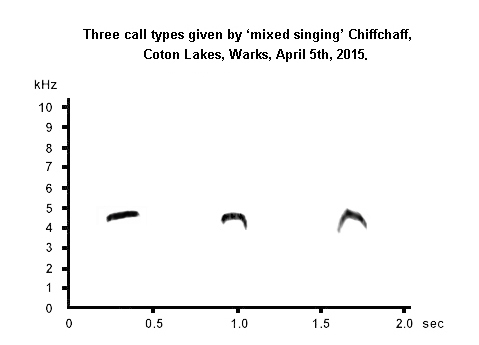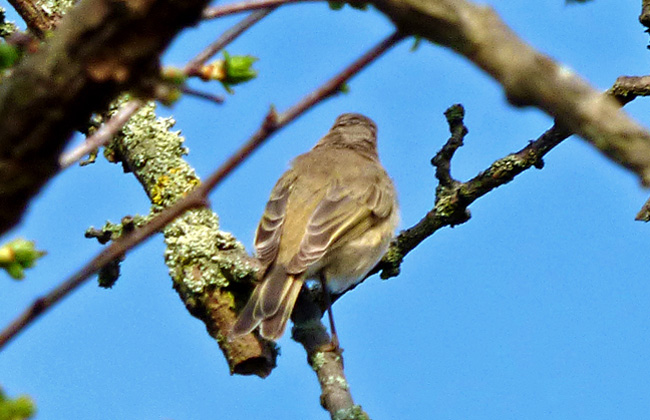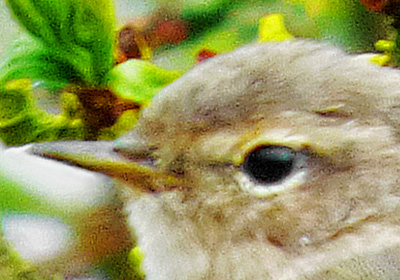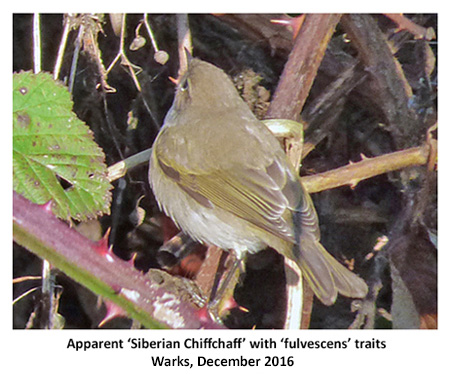A case study from Warks, April 2015 : a returning 'mixed singer' |
In April 2015, a 'mixed singing' individual first seen at Coton Lakes, Warks, during March 2014 (see Casestudy3) reappeared at the site. Even a year on, it remained a 'mixed singer', so this was not a temporary caprice by a first-winter bird. However, the repertoire was now dominated by tristis song, with fewer abietinus/collybita notes interspersed, and only occasionally were there extended sequences of complete abietinus/collybita stanzas. An example of the 'mixed song' can be heard here ►. It begins with abietinus/collybita notes and then becomes progressively more tristis-like.
In contrast, the repertoire of calls had become more varied. It now included tristis-style calls and only occasional abietinus/collybita-like 'huit' calls (which were overwhelmingly the dominant call in March 2014). The tristis-style calls tended to have a slightly rising pitch and there was a degree of hesitancy at times in all vocalisations. Also given regularly were inflected 'sweeoo' calls, both inverted 'U' and inverted 'V' in sonogram profiles. The more sharply inflected, inverted 'V' variant was the loudest and most-confidently delivered call, while the shallow rise and fall of the inverted 'U' call made it difficult to distinguish by ear from the typical tristis call but its structure is evident in a sonogram. In some ways, the shallow, inverted 'U' variant of the 'sweeoo' call is structurally intermediate between a typical tristis call and the more sharply inflected 'sweeoo' call (which is an alternative call given regularly by abietinus/collybita). A composite recording of these three 'additional' calls (with some amplification to aid comparison) can be heard here►. A sonogram of these three calls appears in Figure 1.

Fig. 1 Three call variants given by
'mixed singing' Chiffchaff. The first is a tristis-style call
(though its slightly rising frequency is not typical and perhaps a legacy of the
earlier predominance of rising collybita/abietinus calls).
The latter two calls are 'sweeoo' style calls: a shallow, inverted 'U' and a
more sharply inverted
'V' structure in sonogram.
During this second sojourn by the Coton individual some photographs were obtained. As is usual in 'Siberian Chiffchaff' in late-March/April, it was in moult, with rather dishevelled and 'washed out' plumage and with missing or growing feathers in the tertials and central tail (plate 1). The definitive appearance when in fresh plumage cannot be evaluated when a bird is in such a state of moult. However, a yellow tinge in the front of the eye-ring, revealed in photographs (plate 3), in conjunction with such prominent yellow-olive fringes to the remiges and rectrices (which will not be moulted in spring) and very evident olive in the region of the rump and lower back (plate 2) indicate 'riphaeus'-levels of misplaced olive and yellow. Thus, vocal and plumage anomalies implicate introgression and preclude this individual being logged an unequivocal tristis. (It is intriguing to speculate whether the plumages of thoroughbred tristis and individuals with introgressed abietinus genes might diverge further when worn and / or in heavy moult.)

© A. R. Dean
Plate 1. Chiffchaff with 'mixed
song', Coton Lakes, Warks, April 2015.
In moult : note especially tertials and rectrices.

© A. R. Dean
Plate 2. Chiffchaff with 'mixed
song', Coton Lakes, Warks, April 2015. Evident yellowish-olive fringes to
flight-feathers.
Colours of head and body rather 'washed out' (see plate 1) but with prominent olive wash to rump and lower
back.

© A. R. Dean
Plate 3. Chiffchaff with 'mixed song', Coton Lakes, Warks, April 2015.
Front of upper eye-ring with distinct yellow tinge.
There are several interesting aspects to the re-occurrence of this individual. Firstly, it has enabled the appearance of the bird to be established with greater accuracy and captured in photographs. This has confirmed its relatively late moult and the presence of 'misplaced' and / or over-prominent olive and yellow. The prominence of olive and yellow may perhaps become enhanced during heavy moult, at a time when the 'tan-brown' component of tristis plumage becomes temporarily depleted. Secondly, it is an example of a 'Siberian Chiffchaff'-type returning to a site visited in a previous winter, thus demonstrating a purposeful migration strategy rather than wayward vagrancy by a first-winter individual. Thirdly, it demonstrates that, even if the balance of components shifts, 'mixed singing' is not a temporary whim but is persistent. Fourthly, it demonstrates that calls are not immutable : an individual using exclusively 'the wrong' call in one winter may develop an expanded repertoire of calls by a subsequent winter. This expanded repertoire may include the 'correct' call for tristis, though it may still not be employed exclusively, perfectly or delivered with confidence.
It is interesting to compare the distribution and intensity of the olive and yellow hues in the Coton individual with a field-evident 'fulvescens'-style Chiffchaff photographed in Warwickshire in December 2016. This individual was in fresh plumage, with tristis-like hues of tan-brown and buff in its body plumage, but also displayed prominent yellowish-olive margins to remiges, rectrices and wing-coverts. How would this individual appear when worn and in moult?

© A. R. Dean
Plate 4. Apparent 'Siberian
Chiffchaff' with marked 'fulvescens' characters, Warks, Dec 2016.
Compare prominence of yellowish-olive fringes to remiges and rectrices with
those of vocally anomalous Chiffchaff in plates 1 to 3.
Also of interest in the winter of 2014/2015 were the studies by Andrew Warr of two 'Siberian Chiffchaffs' at Powick in Worcestershire. One was a 'classic' tristis in terms of plumage while the second displayed some evident 'fulvescens' traits. Neither sang but both employed a range of calls, including notes with a rising pitch and recalling the calls of collybita/abietinus. These further examples bring to at least seven the number of apparent 'Siberian Chiffchaffs' with anomalous or variant calls which have appeared in the west Midlands region in just over 12 months. Surely, others are being overlooked elsewhere. Andrew Warr's observations are thoroughly documented in his blog article <here>, and include excellent photographs, sound-recordings and sonograms. The photographs also demonstrate just how radically the plumage of 'Siberian Chiffchaffs' is affected by the onset of moult. In photos taken in mid-February, both individuals exhibit brown and buff hues quite typical of tristis. With the onset of moult, by mid-March their appearance has changed radically. The brown and buff hues have become significantly reduced and replaced by a dishevelled and much greyer livery. They appear similar to the Coton individual above, confirming that such an appearance is characteristic during moult but differs quite radically from the 'definitive' appearance in fresh plumage.
|
|